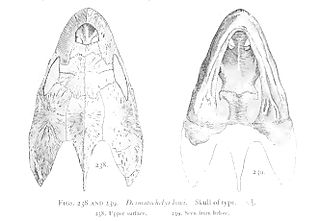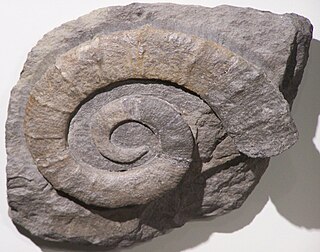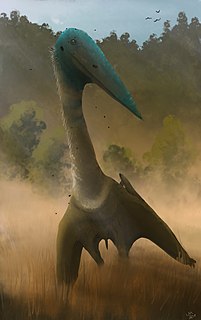Cimolodon is a genus of the extinct mammal order of Multituberculata within the suborder Cimolodonta and the family Cimolodontidae. Specimens are known from the Late Cretaceous of North America.

Avisaurus is a genus of enantiornithine bird from the Late Cretaceous of North America.
Phaedrolosaurus is a genus of theropod dinosaur, based on a single tooth possibly from the Valanginian-Albian-age Lower Cretaceous Lianmugin Formation of Wuerho, Xinjiang, China.
Gobititan is a genus of herbivorous sauropod dinosaur from the Barremian faunal stage of the Early Cretaceous, approximately 129-125 million years ago. The name of this genus is derived from the Gobi desert region and the Titans of Greek mythology, which is a reference to its large body size. The specific name shenzhouensis, is derived from "Shenzhou", an ancient name for China.
Bogolubovia is a genus of pterosaur from the Upper Cretaceous Rybushka Formation of Petrovsk, Saratov Oblast, Russia. It is named for Nikolai Nikolaevich Bogolubov, the paleontologist who discovered the remains in 1914. It was in 1991 assigned to the Azhdarchidae. Wellnhofer (1991) however, retained it in the Pteranodontidae. Bogolubov had initially assigned the specimen, consisting of a single partial large cervical vertebra, as a new species of Ornithostoma, O. orientalis. It was later reclassified as a species of Pteranodon, before being assigned its own genus by Lev Nesov and Alexander Yarkov in 1989. The holotype has probably been lost, but other partial remains have been referred to the genus.
Lonchognathosaurus is a genus of dsungaripterid pterodactyloid pterosaur from the Albian-age Lower Cretaceous Lianmuqin Formation of Xinjiang, China.

Aralazhdarcho is a genus of azhdarchid pterosaur from the Santonian to the early Campanian stages of the Late Cretaceous period of Bostobe Svita in Kazakhstan. The type and only known species is Aralazhdarcho bostobensis.
Eocathayornis is a genus of enantiornithean birds that was probably more basal or "primitive" than related genera Sinornis and Cathayornis. These birds lived during the Early Cretaceous in today's People's Republic of China.
Corsochelys is an extinct genus of sea turtle that lived in the Late Cretaceous (Campanian). Zangerl (1960) named the type species, based upon remains found in Alabama within the Mooreville Chalk Formation.

Toxochelys is an extinct genus of marine turtle from the Late Cretaceous period. It is the most commonly found fossilized turtle species in the Smoky Hill Chalk, in western Kansas.

Desmatochelys is an extinct genus of sea turtles belonging to the family Protostegidae. This genus contains two known species, D. lowii and D. padillai. D. lowii was first discovered in 1895, followed by D. padillai in 2015. Having been estimated at over 120 million years old, D. padillai is currently the oldest known species of sea turtle.

Crioceratites is an ammonite genus from the Early Cretaceous belonging to the Ancyloceratoidea.

Pitekunsaurus is a genus of titanosaurian sauropod dinosaur from the Late Cretaceous Anacleto Formation of Neuquén, Argentina. It was described by L. Filippi and A. Garrido in 2008. The type species is P. macayai. The generic name is derived from Mapudungun pitekun, meaning "to discover", the epitheton honours the discoverer, oil company explorer Luis Macaya, who found the fossil in April 2004.

Volgadraco is a genus of pterodactyloid pterosaur from the Upper Cretaceous of European Russia. Volgadraco was originally classified as an azhdarchid, however, recent studies have concluded that it may belong to either the family Nyctosauridae, or the family Pteranodontidae.
Caririemys is an extinct genus of side-necked turtles, belonging to the Pelomedusoides of the family Euraxemydidae. The type species is C. violetae. A single fossil of an individual was found in the Santana Formation in Brazil, an 80-million-year-old Late Cretaceous deposit that has so far preserved other fossil reptiles such as dinosaurs and crocodilians.
Palmulasaurus is a genus of polycotylid plesiosaur from the Turonian Tropic Shale of Utah. It was originally described as Palmula, but the name was occupied by a genus of Cretaceous foraminifer first described in 1833.
Pahasapasaurus is a genus of plesiosaur. It was an early polycotylid plesiosaur from the Cenomanian of South Dakota, USA. Distinctive features of the taxon include elongate epipodial bones and the nature of the palate bones. The type species is P. haasi.
Gamerabaena is an extinct genus of baenid turtle which existed in North Dakota during the late Cretaceous Period. It is known from a single fragmentary skull that was found in the Maastrichtian-age Hell Creek Formation. It contains the species Gamerabaena sonsalla. Gamerabaena is similar to the genus Palatobaena, but it differs in its lack of a posterior expansion of the triturating surface, a somewhat rectangular skull, and a wide angle between the maxillae. Gamerabaena also has a lingual ridge on the inner side of the jaw that is not seen in Palatobaena.
Larachelus is an extinct genus of basal pan-cryptodiran turtle known from the Early Cretaceous of Spain.

Sulcavis is a genus of enantiornithean birds. One species is named, Sulcavis geeorum. The fossil was found in Early Cretaceous rocks in Liaoning Province, China.









